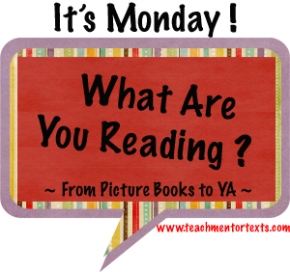As always, be sure to check out the Teach.Mentor.Text and Unleashing Readers blogs by Jen & Kelly, the creators of this meme, for other bloggers participating in “It’s Monday! What Are You Reading?”
I
am so excited to share with you what I've been reading this week! One
of my favorite (and my students' favorite!) authors had a "book
birthday" on Thursday! Ame Dyckman, author of "Boy + Bot," released her second picture book, "Tea Party Rules" and I have been so anxious to read it.
A
wayward bear cub's nose leads him to some yummy cookies and a young
girl's backyard tea party. Cub quickly realizes that there are certain
rules- tea party rules- that he must follow. Will Cub comply
with the girl's code of conduct in order to snag the delicious treats or
is it all too much for him to bear? (ok, pun intended!) The
illustrator, K.G. Campbell, uses wonderful pastel hues done in colored
pencil which contribute greatly to the mood of this lighthearted tale.
Tea Party Rules is a delightfully giggly book about friendship, imagination, and childhood fun!
Professionally, I've been reading "What Readers Really Do: Teaching the Process of Meaning Making" by
Dorothy Barnhouse and Vicki Vinton. I bought this book on the
recommendation of my friend and Maine Reading Association colleague,
Susan Dee. She is one of my "go to" sources for what is new and great
in the world of education and from what I've read so far, her latest
recommendation is spot on! You know you've got a great text on your
hands your hands when you start highlighting it on the first page of the
Introduction! Here are some gems that I have read so far from the
authors...
"...researchers
have now discovered that, more than smaller class size, more than
better funding, more than higher standards or benchmarks, what affects
student performance the most is the classroom teacher" (p. 2).
"...we
don't want students to take on or consume our own interpretations of
texts; we want them to construct their own. This means that we need to
teach each student the way readers think as they read, not what to
think, helping them to experience texts as readers, rather than putting
specific thoughts about a text in their heads" (p. 7).
Another
aspect of reading that Barnhouse and Vinton address is the issue of a
declining focus on narrative texts. With the implementation of the
Common Core State Standards and the call for students to be college and
career ready, there has been increased concentration on expository
texts. However, the authors point out that instruction on narrative
texts is imperative for several reasons. They are the texts that contain
several layers of meaning and, as a result, lead to deeper thinking and
higher levels of comprehension. The authors state that narratives are
also a vehicle for teaching empathy... readers get a chance to become
someone else, live their lives through another character, and learn from
that experience. "This is no small matter in educating students who will be citizens, leaders, and caretakers of our world" (p. 11).
I can't wait to delve deeper into this book!
Jenn
Felt is a certified K-8 teacher, K-6 Literacy Coach, and K-12 Literacy
Specialist with 17 years of experience in the field of education. In
addition to her work in elementary classrooms, she is an adjunct faculty
member for the College of Education at the University of Maine. Jenn
facilitates workshops on a variety of literacy topics at the local,
regional, and national level. Currently, she is on the executive board
of the Maine Reading Association and is pursuing her National Board
certification in the area of literacy. Jenn is passionate about putting
high-quality texts in the hands of young readers, creating learning
environments for optimal student achievement, and developing strong
family-school-community relationships. She can be contacted at:
LiteracyTeacherJenn@gmail.com
*cross-posted at: FeltLikeReading.com



No comments:
Post a Comment